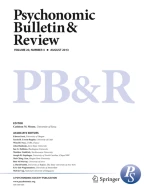Abstract
A growing literature argues that wearing a heavy backpack makes slopes look steeper and distances seem longer (e.g., Proffitt, 2006). To test for effects of experimental demand characteristics in a backpack experiment, we manipulated the experimental demand of the backpack and then used a postexperiment questionnaire to assess participants’ beliefs about the purpose of the backpack. For participants in the low-demand condition, an elaborate deception was used to provide an alternative explanation of the requirement to wear a heavy backpack (i.e., that it held EMG equipment). The highest slope judgments were found for those undeceived participants who guessed that the backpack was intended to affect their slope perception and also reported that they thought they were affected by it. When persuaded that the backpack served another purpose, participants’ slope estimates were no different from those of participants not wearing a backpack. These findings suggest that backpack effects, and other reported effects of effort on perception, are judgmental biases that result from the social, not physical, demands of the experimental context.
Article PDF
Avoid common mistakes on your manuscript.
References
Asch, S. E. (1956). Studies of independence and conformity: I. A minority of one against a unanimous majority. Psychological Monographs, 70, 1–70.
Balcetis, E., & Dunning, D. (2007). Cognitive dissonance and the perception of natural environments. Psychological Science, 18, 917–921.
Bhalla, M., & Proffitt, D. R. (1999). Visual-motor recalibration in geographical slant perception. Journal of Experimental Psychology: Human Perception & Performance, 25, 1076–1096.
Crabtree, C., Norman, J. F., Bartholomew, A., & Ferrell, E. (2008). Aging and the perception of slant from optical texture, motion parallax, and binocular disparity [Abstract]. Journal of Vision, 8(6), 859a. doi:10.1167/8.6.859.
Granrud, C. E. (2009). Development of size constancy in children: A test of the metacognitive theory. Attention, Perception, & Psychophysics, 71, 644–654. doi:10.3758/APP.71.3.644
Hajnal, A., & Durgin, F. H. (2008). The perception of slope by eye, hand, foot and finger: Evidence for an amodal vertical tendency. [Abstract]. Journal of Vision, 8(76), 76a.
Hutchison, J. J., & Loomis, J. M. (2006). Does energy expenditure affect the perception of egocentric distance? A failure to replicate Experiment 1 of Proffitt, Stefanucci, Banton, and Epstein (2003). Spanish Journal of Psychology, 9, 332–339.
Loftus, E. F., Miller, D. G., & Burns, H. J. (1978). Semantic integration of verbal information into a visual memory. Journal of Experimental Psychology: Human Learning & Memory, 4, 19–31.
Loftus, E. F., & Palmer, J. P. (1974). Reconstruction of automobile destruction: An example of the interaction between language and memory. Journal of Verbal Learning & Verbal Behavior, 13, 585–589.
Nisbett, R. E., & Wilson, T. D. (1977). Telling more than we can know: Verbal reports on mental processes. Psychological Review, 84, 231–259.
Orne, M. T. (1962). On the social psychology of the psychological experiment: With particular reference to demand characteristics and their implications. American Psychologist, 17, 776–783.
Proffitt, D. R. (2006). Embodied perception and the economy of action. Perspectives on Psychological Science, 1, 110–122. doi:10.1111/j.1745-6916.2006.00008.x
Proffitt, D. R., Stefanucci, J., Banton, T., & Epstein, W. (2003). The role of effort in perceiving distance. Psychological Science, 14, 106–112.
Russell, R., & Durgin, F. H. (2008). Demand characteristics, not effort: The role of backpacks in judging distance [Abstract]. Journal of Vision, 8(6), 755a.
Schachter, S., & Singer, J. (1962). Cognitive, social, and physiological determinants of emotional state. Psychological Review, 69, 379–399.
Schnall, S., Harber, K. D., Stefanucci, J., & Proffitt, D. R. (2008). Social support and the perception of geographical slant. Journal of Experimental Social Psychology, 44, 1246–1255.
Stefanucci, J. K., Proffitt, D. R., Clore, G. L., & Parekh, N. (2008). Skating down a steeper slope: Fear influences the perception of geographical slant. Perception, 37, 321–323. doi: 10.1068/p5796.
Tversky, A., & Kahneman, D. (1974). Judgment under uncertainty: Heuristics and biases. Science, 185, 1124–1131.
Wason, P. C. (1960). On the failure to eliminate hypotheses in a conceptual task. Quarterly Journal of Experimental Psychology, 12, 129–140.
Witt, J. K., Proffitt, D. R., & Epstein, W. (2004). Perceiving distance: A role of effort and intent. Perception, 33, 570–590. doi:10.1068/ p5090
Woods, A. J., Philbeck, J. W., & Danoff, J. V. (2009). The various perceptions of distance: An alternative view of how effort affects distance judgments. Journal of Experimental Psychology: Human Perception & Performance, 35, 1104–1117.
References
Bhalla, M., & Proffitt, D. R. (1999). Visual-motor recalibration in geographical slant perception. Journal of Experimental Psychology: Human Perception & Performance, 25, 1076–1096.
Hutchison, J. J., & Loomis, J. M. (2006). Does energy expenditure affect the perception of egocentric distance? A failure to replicate Experiment 1 of Proffitt, Stefanucci, Banton, and Epstein (2003). Spanish Journal of Psychology, 9, 332–339.
Macknik, S. L., King, M., Randi, J., Robbins, A., Teller, Thompson, J., & Martinez-Conde, S. (2008). Attention and awareness in stage magic: Turning tricks into research. Nature Reviews Neuroscience, 9, 871–879.
Proffitt, D. R. (2009). Affordances matter in geographical slant perception: Reply to Durgin, Baird, Greenburg, Russell, Shaughnessy, and Waymouth. Psychonomic Bulletin & Review.
Russell, R., & Durgin, F. H. (2008). Demand characteristics, not effort: The role of backpacks in judging distance [Abstract]. Journal of Vision, 8(6), 755a.
Schnall, S., Harber, K. D., Stefanucci, J., & Proffitt, D. R. (2008). Social support and the perception of geographical slant. Journal of Experimental Social Psychology, 44, 1246–1255.
Woods, A. J., Philbeck, J. W., & Danoff, J. V. (2009). The various perceptions of distance: An alternative view of how effort affects distance judgments. Journal of Experimental Psychology: Human Perception & Performance, 35, 1104–1117.
Author information
Authors and Affiliations
Corresponding author
Additional information
This article was supported by a Swarthmore College faculty research award to F.H.D.
Rights and permissions
About this article
Cite this article
Durgin, F.H., Baird, J.A., Greenburg, M. et al. Who is being deceived? The experimental demands of wearing a backpack. Psychonomic Bulletin & Review 16, 964–969 (2009). https://doi.org/10.3758/PBR.16.5.964
Received:
Accepted:
Issue Date:
DOI: https://doi.org/10.3758/PBR.16.5.964
